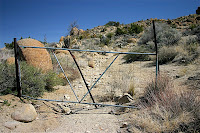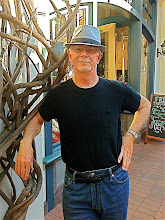Thursday, March 25, 2010
The Desert Queen
(Remember that you can double click on any photo to see it full screen.)
It was around noontime as I found a large flat boulder that would suit my purpose. I climbed up, opened my pack and spread out my lunch: two chunks of gruyere cheese, some sliced pepper salami, a peanut butter sandwich, sweet craisins and plenty of water. A feast! My lunch spot was in a desert canyon. I was alone as can be, because I was far from any trail.
I had started my hike at an unmarked back country trail at the side of a washboard dirt road a mile off the paved National Park road. The trail was an easy walk through the joshua tree-studded hills. I anticipated seeing no one, and no one was who I saw.
Thirty minutes into my hike, an old metal cattle gate blocked the trail. The fence that once complemented the gate was long gone. I stepped around the gate and continued, the only sounds being the wind that had blown in the night before and my boots crunching on the desert gravel. The wind was chilly and blunted the edge of the desert sun.
The rough dirt road I had taken to get here is called Desert Queen Mine Road, and I thought this trail might lead me to the ruins of the Desert Queen. I knew that a man named Frank James found gold here in 1894. Jim and Bill McHaney took over the mine when one of their hired cowboys shot and killed James. Bill Keys eventually took oversight of the mine from the McHaney brothers. The Desert Queen proved elusive to me. (I did find it later, a mile down the road, at a well-marked parking lot with a bathroom.) On this hike,I did find two shafts - deep, dark, forbidding holes in the ground with a flimsy piece of US Park Service wire staked around their perimeter; but no sign of any mine buildings.
To my disappointment, the trail ended after about a mile and a half at a ridge overlooking a canyon. I wandered along the ridge for a while, reluctant to leave. Finally, I turned and walked fifty yards in the direction from which I had come, but I still didn't want to go back. I returned to the ridge, arraigned a few flat rocks into a noticable cairn, stepped off the trail and descended toward the canyon. I walked about twenty-five yards and turned back to look for the cairn. It was still visible, reassuring. I piled more rocks and continued. Each time I gathered rocks, I was careful to nudge them with my booted foot before reaching to grab them with my hand. My eyes told me there was no place for a rattlesnake to hide behind these relatively small rocks, but why take chances?
My excitement rose as my pace slowed. I went deeper and deeper into the canyon, farther from the trail, building my cairns. I came upon a wash, a dry stream bed, that stood out like a superhighway in the barren chaos of sand and rock, and I followed it. I saw animal footprints but no sign of human passage. I continued on for about a half hour until I reached the canyon floor. I didn't need as many cairns in the wash, but if a fork or a turn appeared, I was careful to mark my direction.
Eating my luncheon feast, I had achieved my goal. Nobody in the world knew where I was. Hell, I didn't know where I was. This wasn't northern Minnesota canoe country, a place where I am familiar with the challenges and dangers. This was the desert, strange land. My heart rate picked up a bit. I fought the urge to cram food into my mouth, pack up and head back, on the double. I chewed slowly. I breathed deeply. I let my eyes roam across the stark beauty surrounding me. I sat there until it felt okay to leave.
All I had to do now was retrace my steps, cairn by cairn. I started back up the wash and completely missed my first marker! Take it easy, I told myself. Breathe. It's there. You marked the trail yourself less than an hour ago.
And it was there. The second cairn, as well as the rest, were all where they were supposed to be. Some were easier to spot than others. Rocks in the desert, even when stacked by human hands, still look like rocks in the desert. I threaded my way up the canyon wall and back to the trail. At the car, I scratched out the first draft of this journal entry as I sipped a bottle of cold Corona.
When I had returned to the ridge and found the marked trail, I paused a moment and looked back into the canyon. Next time, I promised myself, I'd go farther.
POSTSCRIPTS
* A nice California red wine to go with that Dinty Moore beef stew? That's what I planned, since I was carrying a bottle Carol and I had purchased in Carmel. Of course, I had forgotten a corkscrew; so, bottle in hand, I wandered the campground asking for help. The first couple I asked had the same problem - a bottle of wine and no way to open it. It wasn't long before I got what I wanted, though. A woman walking her dog (a retired teacher, no less!) heard my plight and took me back to her campsite, where I met her husband and got my bottle opened. George and Ruth invited me back after dinner when it would be dark enough to stargaze through George's telescope. I took them up on their offer and got to see the rings of Saturn and other amazing sights.
** One night was so windy that I took the tent down, piled rocks on it and slept in the car. It was a long night. A few years ago, in Arches National Park, straight line winds had torn the rainfly and bent a tent pole; I didn't wish to repeat that incident.
*** There is, of course, no water in the desert. The visitor centers at the north and south entrances to Joshua Tree National Park have spigots where campers can fill their canteens and jugs with water. At the west entrance, a gift shop across the street from the visitor center has a spigot for common use, donations gratefully accepted in the glass jar on the counter by the cash register.
At the entrance gate at the western entrance, there is also water. When I stopped to fill up there one day, I discovered that the spigot was governed by a mechanical regulator. Insert twenty-five cents for fifty seconds of usage. I was annoyed, but I paid my two bits. In this little episode lies the kernel of the story that defines human settlement of the southwest. Whose water is it? Water is a topic here, not one easily entered into, but one on everyone's minds. I saw it in the angry road signs along Interstate 5 as I drove through the irrigated farmlands of the central valley. I saw it in the eyes of the park ranger when I made a light comment on paying for the water. I saw it in Palm Springs, with its golf courses and the ubiquitous restaurant mist sprayers. I heard it in a woman's comment that Palm Springs has an aquifer beneath it with all the water that will ever be needed. The problem of water will not go away, inspite of the denial shown in the woman's comment. In fact, most people agree that it will only get worse. For a stark and fascinating look at the politics and realities of water in the American southwest, pick up a copy of "Cadillac Desert."
That's it until my next trip. May all your journeys be good ones.
Subscribe to:
Post Comments (Atom)







1 comment:
Wow. You have a lot of blogs.
It will take me a while to go slowly though each one. This one you should submit as an article to somewhere. NYTimes? Strib? Southwest Journal?
Carol
Post a Comment